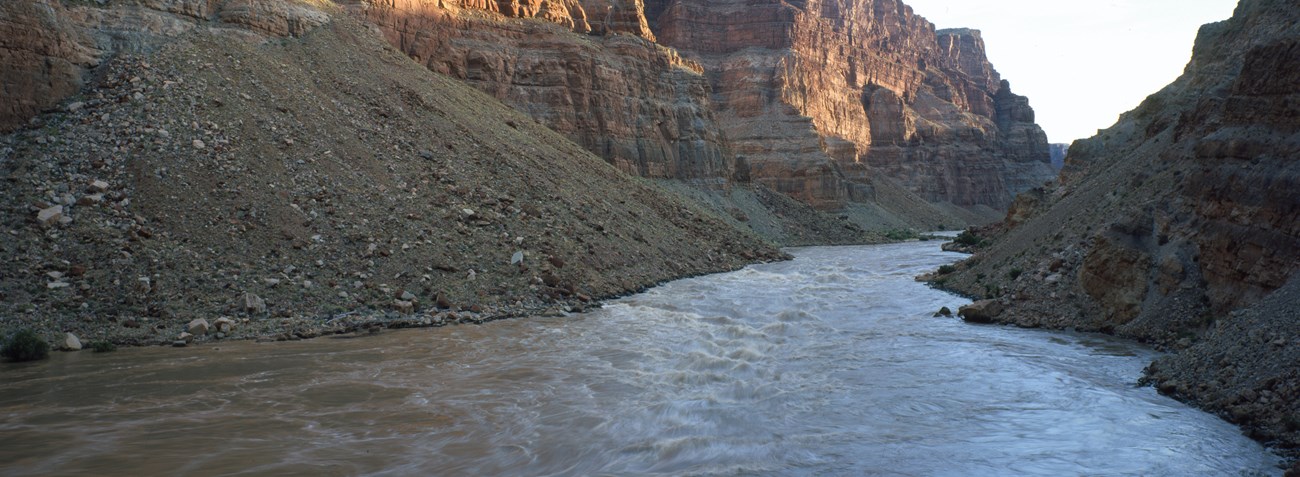Last updated: November 4, 2024
Article
Keeping Up with the Contaminants: Monitoring the Impact of Improved Wastewater Technology on the Colorado River Near Arches and Canyonlands National Parks

Thousands of chemical compounds enter our water systems each day. But investment in new technologies can reduce the levels of contaminants we already target with wastewater treatment, and a lot of others we don’t. This a win for everyone who depends on clean water for health and survival—and for the places we cherish.
Unregulated Contaminants: A Growing Concern
It’s not a stretch to say that in large part, we don’t really know what’s in our water. Of the thousands of chemicals we collectively use each day, only a small number are regulated—and thus tested for and targeted by wastewater treatment. Unregulated wastewater contaminants aren’t necessarily harmless. They’re substances whose effects on human health and the environment we don’t yet know. Examples of these “emerging” wastewater contaminants include pesticides, pharmaceuticals, and personal care products. Some, like caffeine, cholesterol, and nicotine, are so common that scientists recognize them as indicators that wastewater is present in a water body. With new compounds emerging in products all the time, how can we keep up? In Moab, Utah, the National Park Service’s Northern Colorado Plateau Network (NCPN) is helping to determine whether improved methods of wastewater treatment can help reduce the presence of unregulated contaminants in effluent (cleansed discharge from a wastewater treatment plant). The results have important implications for water quality in some of our nation’s most treasured rivers—and the news is good.
Visitation and Infrastructure
In 2018, the city of Moab, Utah, opened a brand-new wastewater treatment plant (WWTP). The town’s previous wastewater plant was built in the 1950s, when Moab was undergoing a uranium-driven population boom. Through subsequent booms and busts, Moab’s population has remained fairly stable, at around 5,000 residents. But its tourism numbers have changed almost unimaginably. From 1960 to 2020, annual visitation to nearby Arches and Canyonlands national parks rose by more than 2,000% (yes, you read that right), from about 72,000 to 1.75 million people.

That’s a lot of showers and toilet flushes. Moab’s new WWTP has an increased capacity and uses state-of-the-art technology (a sequencing batch reactor with activated sludge and UV disinfection). These changes are expected to improve water quality at the location of the plant’s outflow: the Colorado River, a major water source for irrigation, drinking water, fishing, and recreation. The main goal of the new facility is to reduce nutrient concentrations in the effluent—the typical goal of wastewater treatment. But could the treatment process also reduce the effects and concentration of unregulated contaminants in the outflow? That’s what a team of scientists from the US Environmental Protection Agency (EPA), US Geological Survey, and NCPN wanted to find out.
Problems and Opportunities
Prior to 2018, NCPN monitoring of emerging contaminants helped identify chronic contamination in the Colorado River downstream of Moab. The Potash boat ramp, about 24 kilometers from Moab’s treatment plant, is a heavily used launch site for river trips entering Canyonlands National Park. In samples collected there, more emerging contaminants showed up again and again than at any other site the network studied. They included two personal care products (caffeine and DEET), two pesticides (2,4-D and metolachlor ESA), and six wastewater indicators.
Samples collected upstream of the Moab WWTP did not show the same patterns. This suggested that the plant’s effluent outflow could be their source. At this point, staff from the EPA’s Region 8 and Office of Research and Development decided to follow the Moab WWTP replacement more closely. It would be impossible to determine standard thresholds for every potential contaminant, so that office is developing methods to determine the effects of complex chemical mixtures on the environment. Moab offered a perfect opportunity to investigate the following questions:
- Can wastewater treatment improvements designed to reduce nutrients (like the new Moab WWTP) also reduce the amount of synthetic organic contaminants (like prescription drugs and personal care products) in effluent?
- Will this translate to lower bioactivity of water in the Colorado River near Moab, and in fish exposed to the water?
What is bioactivity?
In water-quality terms, bioactivity is the ability of certain substances to initiate changes to living cells. These changes can cause adverse health outcomes, including abnormal growth, impacts on sexual differentiation and development, and, in some species, death. Bioactivity is a measure of action, not contents. Instead of identifying everything present in the water, it identifies the combined effects of everything present in the water.
Testing the Waters
To answer these questions, agency staff collected bimonthly water-quality samples before and after the new WWTP came online in October 2018. Samples were taken at 11 sites along the Colorado River upstream and downstream of the plant. They were analyzed for bioactivities and concentrations of bioactive contaminants (many of which are emerging contaminants). In addition, fathead minnows were deployed in cages anchored at several sites at and near the outflow.
The researchers tested for bioactivity in two ways.
- Analysis of bioactivities exposed different cell lines to water samples to see if the complex mixture of contaminants in the river changed the cell lines in specific ways.
- Analysis of bioactive contaminant concentrations determined how much of each individual contaminant was detected in a given water sample.

New Technology Brings Improved Conditions
Bioactivities
Before Moab’s new WWTP opened, monitoring consistently detected three prominent bioactivities:
- Estrogen receptor activation (ER, important to regulation of reproduction)
- Glucocorticoid receptor activation (GR, important to regulation of stress response)
- Peroxisome proliferator-activated receptor gamma (PPARγ) activation (involved in regulation of body fats)
Minimal bioactivity was detected upstream from the WWTP, and the bioactivities rapidly diminished downstream. This told us the bioactivities were associated with the Moab WWTP outflow. After the new plant came online, detections of ER, GR, and PPARγ activities in water samples collected near the new outflow were substantially reduced.
Bioactive chemical concentrations
Of the 131 pharmaceuticals and steroid hormones screened for before the plant replacement, 62 were detected in surface water at the WWTP outflow site. Afterward, bioactive contaminants were markedly reduced in diversity and concentration. In 2019, 36 chemicals were detected. They were reduced both in number and in concentration, with two exceptions: guanylurea and oseltamivir (i.e., Tamiflu®), which increased in concentration in 2019. Hormones followed similar trends.
Fish
All the fish deployed in cages at the WWTP outflow site prior to plant replacement died. This was likely due to concentrations of unionized ammonia that were roughly twice the rate that begins to affect the health of fathead minnows. The “no observed effect” concentration of unionized ammonia (NH3) for fathead-minnow survival is 440 mg/L. The NH3 concentration at the WWTP outflow site in April 2018 was nearly twice that (847 mg/L). Survival/recovery ranged from 92% to 100% at all other sites. After the WWTP replacement, all minnows used for sampling survived.

Reason for Hope
Each year, thousands of new chemical compounds are put into commercial products that end up in the waste stream—and ultimately, our waters. We can’t test for all of them, and we really don’t know their environmental effects, or how they interact with each other. But what we can do is investigate the effects of the chemical combinations we’ve created in our streams and rivers, while targeting the most potentially harmful substances for regulation. The City of Moab’s commitment to maintaining a clean Colorado River, in collaboration with federal-agency monitoring, produced a perfect opportunity to study the effects of contaminant mixtures and the ability of new technologies to minimize them.
The results from this study indicate that the improved technologies of the new Moab WWTP resulted in effluent discharge with fewer detected bioactive contaminants, lower instream bioactivities, and increased fish survival. The treatment process dramatically reduced the number and concentration of pharmaceuticals and hormones in the outflow, with many pharmaceuticals dropping below detection limits. Continued monitoring will help determine if the improvements are sustained over time.
Aging infrastructure is a problem facing our national parks and our nation as a whole. But through improved technologies, we can tackle not only the problems we’ve got but also those we see heading toward us. In this case, long-term monitoring is helping evaluate technologies with the potential to make our rivers a better place for animals to live and humans to enjoy far into the future.
Information in this article was summarized from Effects-Based Monitoring of Bioactive Chemicals Discharged to the Colorado River before and after a Municipal Wastewater Treatment Plant Replacement, by Jenna E. Cavallin, William A. Battaglin, Jon Beihoffer, Brett R. Blackwell, Paul M. Bradley, Alexander R. Cole, Drew R. Ekman, Rachel N. Hofer, Julie Kinsey, Kristen Keteles, Rebecca Weissinger, Dana L. Winkelman, and Daniel L. Villeneuve. Environmental Science & Technology 2021 55 (2):974–984. DOI: 10.1021/acs.est.0c05269.
The primary job of the Northern Colorado Plateau Network is to provide park managers with the science they need for informed decisionmaking. But because our data are publicly funded and publicly available, they can also be used to support all kinds of other important research. None of the agency offices involved in this study has any direct regulatory authority.
Tags
- arches national park
- canyonlands national park
- monitoring
- contaminants
- water quality
- colorado river
- moab
- ncpn
- northern colorado plateau network
- northern colorado plateau
- science
- canyonlands national park
- wastewater
- wastewater management
- rivers
- water
- water pollution
- water monitoring
- water quality monitoring
- water resources
- water treatment
- water testing
- river management
- river monitoring
